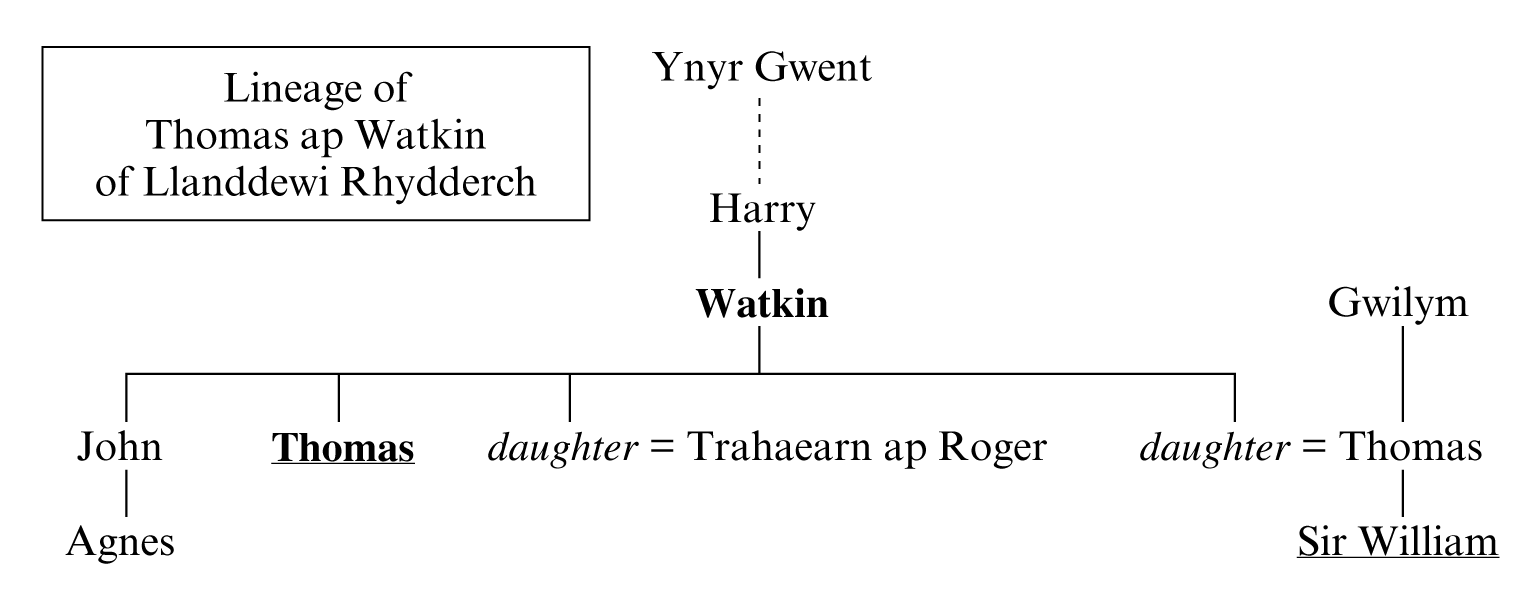Very little is known of Thomas ap Watkin, the recipient of poem 4. The by-name Fychan (Vaughan) given to him in GGl is an error, for he did not belong to the Vaughan family.
Lineage
Bartrum notes him as a descendant of Ynyr Gwent (WG1 ‘Ynyr Gwent’ 7), although the precise descent is unknown. Bartrum also records that a sister of his married Thomas ap Gwilym, the father of Sir William ap Thomas of Raglan. Those named by Guto are shown in bold print and the names of his patrons are underlined.

Lineage of Thomas ap Watkin of Llanddewi Rhydderch
His career
The name Thomas Watkyns occurs in the muster roll of the duke of York’s expedition of 1441, but as an archer, which is slightly surprising for a man of the status implied by this poem. In the same group of soldiers is found the name Jehan Watkyns, this time as a lance, or mounted man-at-arms, and Bartrum notes a brother of Thomas ap Watkin called John. If this archer is Guto’r Glyn’s patron, was he perhaps still a young man? The emphasis in the poem on Thomas taking his father’s place suggests that Watkin had died fairly recently, and indeed Guto implies that Watkin gave him patronage (line 44). However, this is hard to reconcile with the marriage, noted by Bartrum, between Thomas’s sister and the father of Sir William ap Thomas, since William himself was already old enough to marry in 1406 (Thomas 1994: 4). Less problematic is the marriage noted by Bartrum between another of Thomas’s sisters and Trahaearn ap Roger, in all probability the same man who was coroner of Wentloog in 1435–6 and again in 1448–9 (Evans 2008: 296; Morgan ap Roger).
Llanddewi Rhydderch
Llanddewi Rhydderch is a small village between Abergavenny and Raglan. The home of Thomas ap Watkin probably stood on the site of the present Court Farm (SO 354131). Bradney (1991: 282–3) notes that in the fifteenth century half the manor of Llanddewi Rhydderch was in the possession of John ap Watkin ap Henry, the brother of Guto’s patron. After him the lands passed to his daughter Agnes and her husband.
Bibliography
Bradney, J.A. (1991), A History of Monmouthshire, Vol. 1, Part 2a: The Hundred of Abergavenny (Part 1) (reprint, London)
Evans, D.F. (2008), ‘ “Talm o Wentoedd”: The Welsh Language and its Literature, c.1070–c.1530’, R.A. Griffiths et al. (eds.), The Gwent County History, 2: The Age of the Marcher Lords, c.1070–1536 (Cardiff), 280–308
Thomas, D.H. (1994), The Herberts of Raglan and the Battle of Edgecote 1469 (Enfield)





